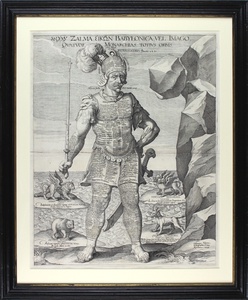| Method | Copper engraving |
| Artist | Wolfgang Kilian |
| Published | Wolfgangus Kilianus, Eiconographus et civis Augustanus 1623 |
| Dimensions | Image 462 x 366 mm, Plate 470 x 374 mm, Sheet 545 x 403 mm |
| Notes |
A large and heavily annotated depiction of the giant figure from the Dream of Nebuchadnezzar in the biblical Book of Daniel. One of Kilian's rarest and most esoteric compositions, it was separately published by the artist in 1623. The present example, having a central fold, was likely bound into an illustrated bible, most probably to accompany the Book of Daniel or Revelations. The giant, clad in ornamental armour in the Dutch classical style, stands on a sea shore beside a rocky cliff. He carries a sceptre and rests his left hand against his hip, where a large, eagle-pommelled falchion hangs from his belt. On his head, he wears an open faced helmet with an elaborate plumed crest. The figure's entire body is covered in text, outlining the history and individuals of the Four Ages of man: Gold, Silver, Bronze, and Iron. Behind the figure, four islands have risen from the turbulent sea. Each houses a different allegorical beast, representing each of the ages in decline. The winged lion represents Babylon and Assyria, and the age of Gold, where Saturn and Jupiter reign supreme. The tusked bear is the Empire of the Medes, the age of Silver and the coming of Mars and Sol. The third kingdom, that of bronze, is depicted as a winged, four-headed leopard, a creature which represents the fractious kingdoms of the successors of Alexander the Great. Finally, the Age of Iron and the Empire of Rome is depicted as the Beast of Revelations, a dog like creature crowned with horns numbering 10 and 7. The figure is the central part of a recurring dream that afflicts the Babylonian king Nebuchadnezzar. The king, troubled and unable to interpret the dream, describes it to his various soothsayers, mystics, and magicians, but each in turn is unable to elucidate its meaning. Their fraudulence is punished by Nebuchadnezzar with death. The Hebrew captive, Daniel, is finally able to provide the king with an answer, explaining that the figure's constituent parts, of gold, silver, bronze, and iron, represent the great empires that will rise and fall before the coming of the Messiah. The figures helmet, its 'head of gold' contains the names of the great tyrants of the Old Testament. Nebuchadnezzar's own name is emblazoned across the figure's moustache, while the names of Daniel and Ezekiel, the 'eyes' of the Lord, are written across his eyebrows. The second age is written across the figure's pectorals, and includes the names of the most famous Persian kings, including Cambyses, Darius, and Xerxes. At the figure's abdomen, the empires of the world fragment. Below Alexander, the line of kings and tyrants is divided geographically, into the Empires of the Ptolemies in Egypt, the Seleucids in Babylon, and the Antiochids in Asia Minor. The final kingdom is ushered in with the conquests of Julius Caesar, and the dominance of Rome. The emperors themselves are listed on the figure's kilt. Each age is also annotated with its date of commencement, measured from the year of creation ('Anno Mundi'), and its duration. Unlike most interpretations of the Dream of Nebuchadnezzar, Kilian's depiction does not end with the rift of the Roman empire into East and West, but instead presents the division as ongoing. Each leg, made of mingled clay and iron, includes a list of monarchs of East and West, drawing particular attention to the conflict between Christianity and Islam as personified by the Holy Roman Emperor Ferdinand II and the Ottoman Sultan Mustapha. The world itself is divided into nations on the figures toes. On the right foot are Germania, Hispania, Anglia, Italia, and Gallia. On the left are the lands of the Ottoman empire, Graecia, Syria, Asia, Aegyptus, and Aphrica. To the right of the scene, the fatal boulder teeters on the cliff-side, ready to sweep away the Kingdoms of Men, and become the mountain that will hold the Kingdom of Heaven. Wolfgang Kilian (1581-1662) was a German artist and printmaker, and a member of the Augsburg-based Kilian family of engravers. He was the son of Bartholomaus Kilian the Elder, brother to Lucas Kilian, and father of Bartholomaus Kilian the Younger and Philipp Kilian. Condition: Central horizontal fold. Repaired cut to centre fold, with minor loss. Minor creasing to centre fold. Otherwise a strong and crisp impression with full margins. Framed in a period style frame. |
| Framing | framed |
| Price | £2,750.00 |
| Stock ID | 41102 |

